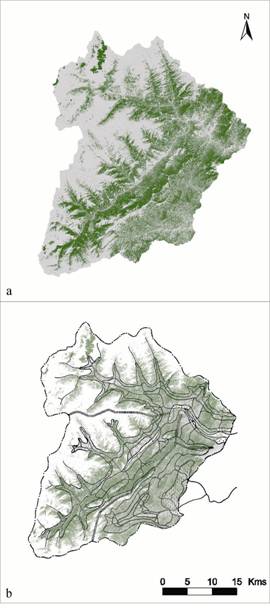College of Liberal Arts & Sciences
Remote Sensing of Human/Environment Interactions
Household/Landscape Interactions: Remote sensing data enhance our ability to monitor and model the interactions between human activities and natural systems at landscape to regional-level scales. Of particular interest here is the ability to study the impacts of land use and land-cover change on the spatio-temporal dynamics of natural systems using remotely sensed data and the incorporation of these data into spatially explicit models to examine the interactions between human and natural systems.

A household in the Niutoushan region of Wolong Nature Reserve
Accurate measures of human effects on landscape processes require consideration of both the direct impacts from human activities and the indirect consequences of the interactions between humans and the landscape. This is particularly evident in systems experiencing regular natural disturbances such as in the mountainous areas of southwestern China, where the remaining populations of giant pandas (Ailuropoda melanoleuca) are supported.
Here the spatiotemporal patterns of human impacts, forests, and bamboo episodic die-offs combine to determine the distribution of panda habitat. To study the complex interactions of humans and landscapes, we developed an integrated spatiotemporally explicit model of household activities, natural vegetation dynamics, and their impacts on panda habitat. Using this model we examined the direct consequences of local fuelwood collection and household creation on areas of critical giant panda habitat and the indirect impacts when coupled with vegetation dynamics.

From Liu, Linderman, et al. 2001
For example, remote sensing data now provide at least decades of detailed, spatially-explicit information on human impacts. Using declassified spy satellite photography from the 1960’s and civilian satellite imagery from 1970 – 1990’s, we examined human impacts on giant panda habitat over several decades.
These data allowed us to estimate not only the quantity of changes, but also to examine the potential impacts from the timing and spatial arrangement of the changes (Linderman et al. 2005). Measures of habitat quality and landscape indices were used to asses the spatial implications of land-cover changes. To examine the interactions between households and the landscape, I developed a model to study the indirect impacts of the removal of forest cover on understory bamboo dynamics.
Bamboo species typically undergo a regular mass seeding and die-off event before returning to pre-die-off quantities and distribution. We found that the timing and spatial distribution of human impacts may have a considerable impact on this natural dynamic of bamboo species through the removal of forest cover and, consequently, species that rely on bamboo such as the giant panda (Linderman et al. 2006).
We found that over the next 30 years household impacts would result in the loss of up to 30% of the habitat relied on by pandas during past bamboo die-offs. The accumulation and spatial distribution of household impacts would also have a considerable indirect influence on the spatial distribution of understory bamboo. While human impacts influence both bamboo die-off and regeneration, over 19% of pre-existing low-elevation bamboo habitat may be lost following an episodic die-off depending on the severity of the impacts and timing of the die-offs. Our study showed not only the importance of the spatial distribution of direct household impacts on habitat, but also the far-reaching effects of the indirect interactions between humans and the landscapes they are modifying.

Indirect human impacts on bamboo cover (Linderman et al. 2006)

Monitoring the distribution of understory bamboo (Linderman et al. 2004)

Modeled human modification of forest cover
(Linderman et al. 2005)
References
- Linderman MA, An L, Bearer S, He G, Ouyang Z, and Liu J. Interactive effects of natural and human disturbances on vegetation dynamics across landscapes. Ecological Applications 16 (2): 452–463 April 2006.
- Linderman MA, An L, Bearer S, He GM, Ouyang ZY, Liu JG. Modeling the spatio-temporal dynamics and interactions of households, landscapes, and giant panda habitat. Ecological Modelling 183 (1): 47-65 Apr 10 2005
- An L, Linderman M, Qi J, Shortridge A, Liu J, et al. Exploring complexity in a human-environment system: An agent-based spatial model for multidisciplinary and multiscale integration. Annals of the Association of American Geographers 95 (1): 54-79 Mar 2005
- Linderman M, Bearer S, An L, Tan YC, Ouyang ZY, Liu HG. The effects of understory bamboo on broad-scale estimates of giant panda habitat. Biological Conservation 121 (3): 383-390 Feb 2005
- Linderman M, Liu J, Qi J, An L, Ouyang Z, Yang J, Tan Y. Using artificial neural networks to map the spatial distribution of understorey bamboo from remote sensing data. International Journal of Remote Sensing 25 (9): 1685-1700 May 2004
- An L, Lupi F, Liu JG, Linderman MA, Huang JY. Modeling the choice to switch from fuelwood to electricity Implications for giant panda habitat conservation. Ecological Economics 42 (3): 445-457 Sep 2002
- Liu JG, Linderman M, Ouyang ZY, An L, Yang J, Zhang HM. Ecological degradation in protected areas: The case of Wolong Nature Reserve for giant pandas Science 292 (5514): 98-101 Apr 6 2001
We are currently extending this work to examine the influence of feedback and the indirect effects of land use on ecosystem processes.